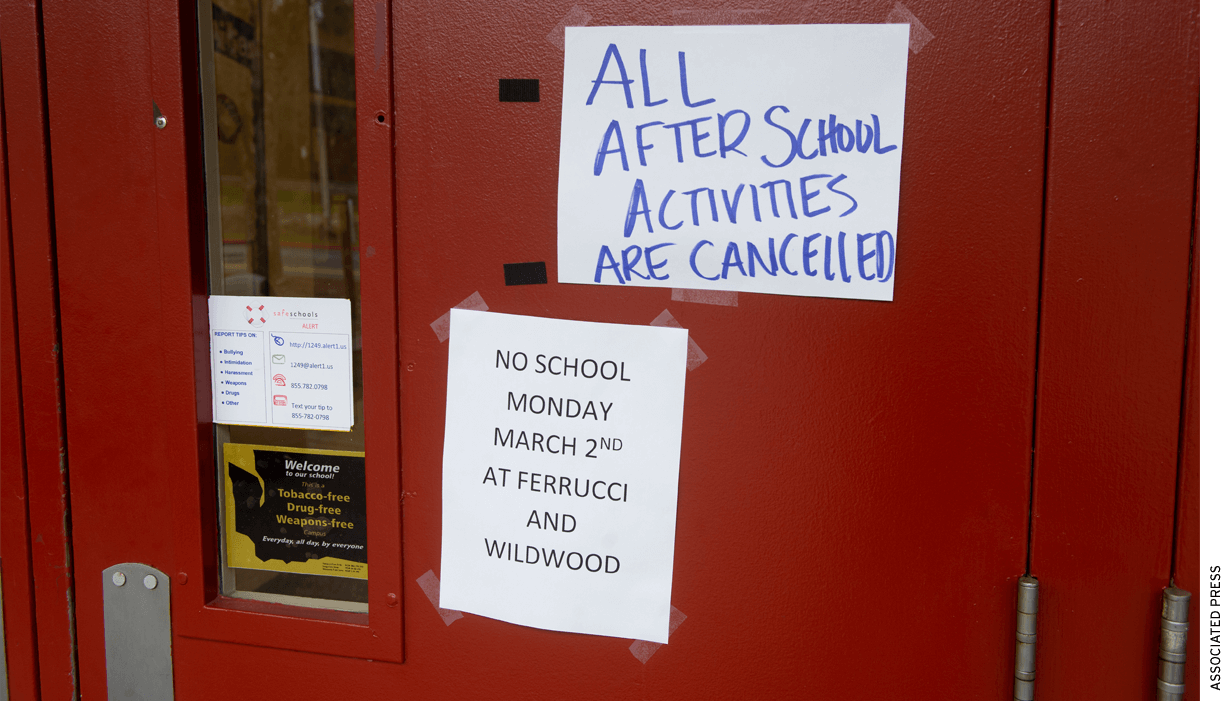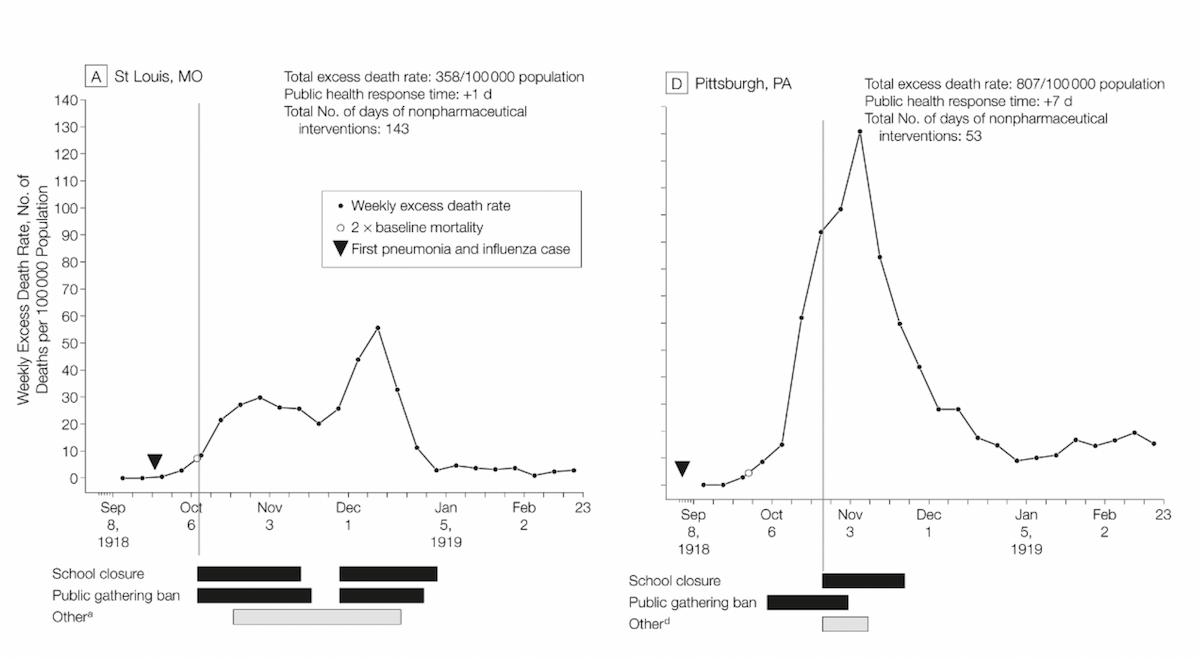
The growing threat of a novel coronavirus pandemic—Covid-19—is forcing governments, businesses, and families, to develop responses in the midst of rapidly changing facts and guidance. While Federal efforts are important, action by state and local officials will be crucial to mitigating the impacts of a pandemic.
In 2005, while serving as deputy policy director at the U.S. Department of Commerce, I served on an interagency team led by the White House Homeland Security Council that developed the National Strategy for Pandemic Influenza and National Strategy for Pandemic Influenza Implementation Plan. The strategy relied heavily on ways of slowing the spread of viral transmissions – “flattening the curve” – to reduce strain on the healthcare system (particularly the need for scarce resources such as beds and ventilators) and provide the time needed to develop and deploy vaccines.
One such measure is closing schools, either reactively in response to a cluster of student infections or preemptively to help slow the transmission rate. Studies analyzing the 1918-1919 Spanish Influenza showed cities that closed their schools earlier also had lower death rates (see figure). For instance, St. Louis closed its schools proactively and experienced a 2.2 percent death rate. Pittsburgh, on the other hand, waited until the peak of the crisis to close its schools and experienced a death rate nearly three times higher.
There were also similar findings from an analysis of the 2009 H1N1 pandemic, which revealed positive benefits from school closures. An additional analysis of 65 papers concluded that “the available data suggest that school closures can potentially reduce transmission during an influenza outbreak, even in the absence of other interventions.”

Source: Markel H, Lipman HB, Navarro JA, et al. Nonpharmaceutical Interventions Implemented by US Cities During the 1918-1919 Influenza Pandemic. JAMA. 2007;298(6):644–654. doi:10.1001/jama.298.6.644
The reason school closures are effective is that children are excellent vectors for viral transmissions given their close contact with one another throughout the day. Once infected, they often pass the virus on to their families who then in turn pass it along to coworkers. Closing schools can help break this chain and create the social distancing helpful in slowing infection rates.
While there is agreement that school closures should be part of a community’s response to a pandemic, there is less agreement as to what conditions should trigger a closure and for how long a school should be closed. For example, in the space of just a few weeks during the H1N1 pandemic in 2009, the CDC advised communities with confirmed cases to close schools for seven days, then 14 days, and then reversed itself giving discretion to local school and health officials. Current CDC guidance for the coronavirus recommends closures of 14 days, or possibly longer, but only if advised by local health officials. This could change, however, as demonstrated recently when Japan and Italy took the aggressive step of closing all of their schools nationwide.
Local officials must also balance the potential public health benefits of closing schools with the other burdens and economic costs placed on a community. As schools close, parents will have to find childcare or stay home from work, creating challenges for employers, including, most importantly, healthcare providers. A 2006 analysis estimated that closing all schools for four weeks during a hypothetical pandemic would lower GDP by $10-47 billion, or 0.1-0.3 percent. Businesses will need to do their part by offering employees flexible work hours, staggered shifts, flexible sick leave, and when possible, the option to work remotely.
Also important in local decisions is weighing the impact of closures on vulnerable workers who depend on hourly work or shifts and are unable to weather the loss of income from prolonged absences. Closure could have an adverse impact for lower-income children who rely on the U.S. Department of Agriculture’s National School Lunch Program for daily meals.
One additional concern with school closures is that children would grow bored and eventually venture out to other public places, thus reducing the social distancing benefits. A survey of students in a closed school during the 2009 H1N1 pandemic found students had “significant interaction with the community and other students.” Students went shopping, visited friends, used public transportation systems, and ate out at restaurants. Communicating to students the importance of social distancing will be critical to maximizing the public health benefits of any closures.
For all these reasons, it is critically important that closures only be done when state and local health officials believe it is absolutely necessary. There are, however, steps schools can take now to prepare. The CDC issued an updated school preparedness guide in 2017 and the U.S. Department of Education has a dedicated website with ongoing guidance.
Despite the challenge of the discontinuity of learning that closing schools presents, there are tools and services available now that weren’t as widely available in 2009. Distance education strategies have been encouraged since 2006 as part of the National Strategy for Pandemic Influenza Implementation Plan and during the 2009 H1N1 pandemic.
For shorter periods of interruption, schools might consider online curriculum options such as LearnZillion, Zearn, Kiddom, Duolingo, Outschool, Tutor.com, and Khan Academy. Video conferencing has also advanced over the last ten years with services such as Zoom, Google Hangout, and Microsoft Teams that can be used to offer low-cost, real-time instruction. And online platforms such as Google Classroom, Canvas and Blackboard can help facilitate instruction and communication among teachers and students.
Some closures might last for more than a month, in which case schools might turn to online courses through providers such as Coursera, and ASU Digital Prep or state-sponsored options such as the Florida Virtual School or Louisiana’s course choice catalog.
Equity concerns must also be considered, as not all students will have the devices and broadband connectivity at home needed to access these resources. Schools might consider lending laptops and mobile hotspots to low-income students. The coronavirus could also give the FCC a chance to pilot expanding E-rate eligibility to subsidize home connectivity for low-income students.
If the 2009 H1N1 pandemic is any guide for today’s coronavirus, then communities need to prepare for uncertainty generated from changing guidance based on an evolving understanding of the virus. Schools and businesses should also prepare now for possible disruptions to ensure they have the communication systems, continuity of work and learning, and technology systems in place if they are needed.
John Bailey is an advisor to the Walton Family Foundation and a visiting fellow at the American Enterprise Institute. He previously served in the White House, U.S. Department of Commerce, and U.S. Department of Education.
Read more from Education Next on coronavirus and Covid-19.


